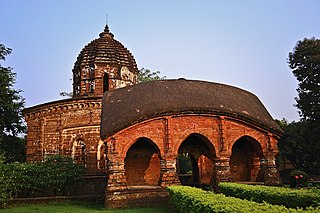
Bishnupur is a city and a municipality in Bankura district, West Bengal, India. It has terracotta temples built by the Malla rulers, historic Radha Krishna temples built during 1600–1800 CE and the Baluchari sarees. In 1997 the temples of Bishnupur were placed on the UNESCO World Heritage Site's Tentative list.

History of Bankura district refers to the history of the present Bankura district in the Indian state of West Bengal. Historically, the region was under the realm of Rarh in ancient Bengal.

Mallabhum was the kingdom ruled by the Malla kings of Bishnupur, primarily in the present Bankura district in Indian state of West Bengal.
Hambir Malla Dev was the forty-ninth king of Mallabhum. He ruled from 1565 to 1620 AD.

Kalipada Singha Thakur was the last King of Malla dynasty of Bishnupur. He became King of Mallabhum in the year 1930 C.E.
Dhari Hambir Malla Dev, also known as Dhari Hambeera was the fiftieth king of the Mallabhum. He ruled from 1620 to 1626 CE.

Raghunath Malla Dev, also known as Raghunath Singha Dev, was the fifty-first king of the Mallabhum. He ruled from 1626 to 1656 CE.
Raghunath Singha Dev II was the fifty-fourth king of the Mallabhum. He ruled from 1702 to 1712.
Durjan Singha Dev was the fifty-third king of the Mallabhum. He ruled from 1682 to 1702.
Nilmoni Singha Dev was the sixtieth king of the Mallabhum. He ruled from 1889 to 1903.
Gopal Singha Dev II was the fifty-eighth king of the Mallabhum. He ruled from 1809 to 1876 CE.
Ramkrishna Singha Dev was the fifty-ninth king of the Mallabhum. He ruled from 1876 to 1885 CE.
Madan Malla was the forty-third king of the Mallabhum, ruling from 1407 to 1420 CE.
Chandra Malla was the forty-sixth king of the Mallabhum. He ruled from 1460 to 1501 CE.
Madhav Singha Dev(also known as Madhab Singha Deba) was the fifty-seventh king of Mallabhum. He ruled from 1801 to 1809 CE.

Radha Madhab Temple is a Hindu temple located in Bishnupur, West Bengal, India.

Madan Mohan Temple or Madanamōhana mandir is a Krishna temple in Bishnupur town of Medinipur division. In the past, the Hindu deity Krishna was worshiped in the form of Madanamohan in this temple, but currently no worship is conducted. According to the foundation plaque found in the temple, the temple was founded in 1694 AD by King Durjan Singha Dev of Mallabhum. The temple is a unique example of ekaratna temple architecture, which belongs to the Ratna style developed in medieval Bengal.

Madan Gopal Temple also known as Pancha-ratna temple, is a Krishna temple in Bishnupur in the Indian state of West Bengal. In this temple, the Hindu God Krishna is worshiped.

Murali Mohan Temple, is a Krishna temple in Bishnupur in the Indian state of West Bengal. In this temple, the Hindu God Krishna was worshiped as Murali Mohan in this temple.

Radha Gobind Temple, is a Krishna temple located in Bishnupur in Indian state of West Bengal.
























